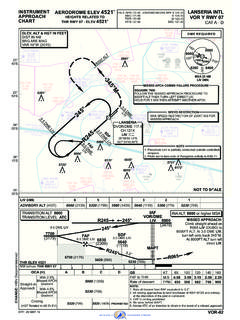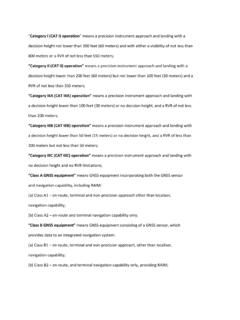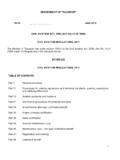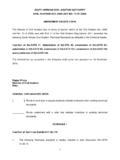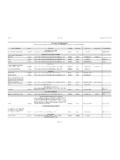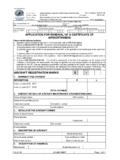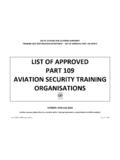Transcription of Section 9 Emergency Procedures - CAA
1 CAA Standards & Procedures (ATCIs) Manual - Section 9 Page 1 of 18 8 February 2013 Section 9 Emergency Procedures Chapter 1 Aircraft Emergencies 1 Introduction The circumstances of each aircraft Emergency can vary to such an extent that detailed instructions cannot be given for every situation. The Procedures outlined in this Section are intended as a general guide and controllers must use their own judgement when handling a particular Emergency . Procedures described in CATS-ATS Standards and Procedures may also be varied to meet an Emergency situation, however, any reduction in separation, necessary to cope with an Emergency , should be restored as soon as possible.
2 Special arrangements, developed locally for handling emergencies, shall be documented in the Station Standing Instruction Manual. 2 Controllers Responsibility Controllers must always be alert to the possibility of an aircraft Emergency . A quick reaction to the situation may be necessary in certain circumstances; however, calm co-ordinated actions are essential in all situations. Controllers shall offer as much assistance as possible to any aircraft which is considered to be in an Emergency situation. An Emergency may require alerting action to be taken immediately or it may develop to that point later.
3 The shift supervisor or Officer-In-Charge, if available, should be informed as soon as practicable and, where more than one ATSU is involved, complete co-ordination must be maintained between units. The supervisor or senior member of the shift should take charge of the operation. Controllers must be ready to give all possible assistance to the ACC, ARCC and other ATSUs. In circumstances where an aircraft is experiencing an Emergency or has declared minimum fuel, or in any other situation wherein the safety of the aircraft is not assured, the type of Emergency and the circumstances experienced by the aircraft shall be reported by the transferring unit to the accepting unit and any other ATS unit that may be concerned with the flight and to the associated rescue coordination centres, if necessary.
4 3 Recognising an Emergency Situation When not directly advised by the pilot of an Emergency situation on board, a Controller may suspect that an aircraft is in an Emergency situation when: a) Radio contact is not established at the time it is expected to be established; CAA Standards & Procedures (ATCIs) Manual - Section 9 Page 2 of 18 8 February 2013 b) Radio contact is lost; c) A pilot makes a report about the malfunctioning of the aircraft or of unusual behaviour of persons on board; d) The erratic behaviour of an aircraft or radar blip is observed; e) The aircraft is overdue at an aerodrome; or f) The pilot reports that the aircraft is short of fuel.
5 If the controller is in radio contact with the aircraft he should ask the pilot if he wishes to declare an Emergency and, if not specified by the pilot, the class of Emergency being declared. More positive indications that an aircraft is in an Emergency are described in the following paragraphs. 4 Distress and Urgency Messages Pilots have been advised that, in the event of an Emergency situation, an ATSU can only provide the necessary priority and handling if the controller is made aware of the Emergency by the crew s formal declaration on the RTF.
6 Pilots have also been advised that the extent to which an ATSU will be able to offer assistance will depend on the amount of information provided and on its being transmitted at the earliest opportunity. Furthermore, it is preferable that if pilots believe that they are facing an Emergency situation, to declare it as early as possible and cancel it later if they decide that the situation allows. There are two classes of Emergency message: a) Distress: A condition of being threatened by serious and/or imminent danger and of requiring immediate assistance; transmitted as MAYDAY, MAYDAY, MAYDAY; or b) Urgency: A condition concerning the safety of an aircraft or other vehicle, or of some person on board or within sight, but which does not require immediate assistance; transmitted as PAN-PAN, PAN-PAN, PAN-PAN.
7 The message will contain as many as possible of the following items: a) Name of the station addressed (time and circumstances permitting); b) Identification of the aircraft; c) Nature of the Emergency ; d) Intention of the person in command; e) Present position, level and heading; f) Qualification of the pilot Student, IMC or full instrument rating (urgency messages); g) As much other information as time permits. CAA Standards & Procedures (ATCIs) Manual - Section 9 Page 3 of 18 8 February 2013 When a pilot has given certain items of information normally associated with an Emergency message but has not prefixed the transmission with 'MAYDAY' or 'PAN', the controller is to ask the pilot if he wishes to declare an Emergency .
8 If the pilot declines to do so, the controller may, if he thinks it appropriate, carry out the necessary actions as if the pilot had declared an Emergency . If a controller considers that another ATSU may be able to give more assistance and, in the circumstances, it is reasonable to do so, the pilot should be asked to change frequency. Pilots should ensure that they prefix the initial message on the new frequency with 'MAYDAY' or 'PAN' to confirm that the Emergency situation still exists. 5 Indication on Radar Pilots may select the following SSR transponder codes to indicate an Emergency situation:- Code 77 (7700) - Aircraft Emergency Code 76 (7600) - Radio Failure Code 75 (7500) - Hijack or other act of violence Note: Flight crew may also activate the appropriate Emergency and /or urgency capability of ADS or transmit the appropriate Emergency message via CPDLC.
9 To indicate an Emergency condition pilots are encouraged to select Code 7700 as soon as is practicable after declaring an Emergency situation, and having due regard for the overriding importance of controlling aircraft and containing the Emergency . However, if the aircraft is already transmitting a discrete code and receiving an air traffic service, that code may be retained at the discretion of either the pilot or the controller. 6 Emergency Aircraft - Selection of Controlling Unit On receipt of information which indicates that an aircraft is in an Emergency , the controller must decide whether or not to transfer the aircraft to another ATSU or sector.
10 The choice will depend upon the circumstances and no hard and fast rules apply. The following guidance material may help controllers to make this decision:- Retaining Control If the controller can offer immediate assistance the aircraft should normally be retained on the frequency. If necessary impose a radio silence on other aircraft or transfer them to another frequency. Alternatively it may be more expedient to transfer the Emergency aircraft to another frequency, particularly if a radio silence would endanger other traffic.

